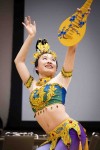Chinese and Japanese communities celebrate the new year on different dates, but participated in Lunar New Year festivities together Sunday night.
The Chinese New Year fell on Feb. 5, while the Japanese New Year is celebrated on Jan. 1. During the Lunar New Year Festival on Sunday however, both student cultural groups showcased how they celebrate the holiday, and were joined by other East Asian organizations as well.
The Association of Chinese Americans collaborated with UCLA Residential Life to present the festival in Carnesale Commons. Members from UCLA’s Nikkei Student Union and Hanoolim, Japanese-American and Korean-American cultural student clubs, were also part of the festival. In past years, the event has consisted of mostly Chinese festivities, but this year’s celebration was more representative of other cultures as well, and included a range of East Asian cultural groups, said Skylar Zhao, a second-year global studies and psychology student, who planned the Lunar New Year Festival as ACA’s culture chair.
“I wanted to make this event a cultural festival for a lot of different Asian countries because this event is also on the Hill, so there will be a lot of people of other ethnicities,” Zhao said. “I just want them to have a taste of different cultures – that’s why we invited NSU, we invited Hanoolim, and we incorporated all of these different clubs.”
The majority of the Lunar New Year festival consisted of dance and music performances, but activity booths were open to attendees throughout the evening as well. Circular tables were covered in red cloth and lined up along the perimeter of the room. Most tables hosted a different craft or game – with flyers detailing their origins – such as crafting paper lanterns. Students could fold and cut a sheet of paper, available in colors such as red, pinks and greens, into the lantern shape. Students also had access to a buffet-style spread in the lobby of Carnesale Commons that served fried rice, mapo tofu and original flavored boba, among other options.
Ian Marquez, a first-year microbiology, immunology and molecular genetics student who attended the event, said he heard about it through Facebook and initially attended for the free food. One of the activities he participated in was letter calligraphy. Even though he is not Chinese, Marquez said he enjoyed writing his name out in the script with the lettering calligraphy because he took Chinese classes during high school.
Other tables offered cultural games, such as the Korean game of Jaegi Chagi, during which players kick a paper jegi – usually paper wrapped around a coin – and try to keep it from hitting the ground. Hanoolim members were invited to the event as Korean and Chinese cultures often overlap, said Bryan Kim, a third-year psychology student and coordinator for the traditional drumming team in Hanoolim. One of the main reasons Koreans also celebrate the Lunar New Year is because they sometimes use the lunar calendar for agricultural practices, as it also serves as a harvest calendar.
“We have a lot of cultural similarities with the Chinese community, and I think Lunar New Year is one of the few things a lot of East Asians in particular celebrate very similarly,” Kim said.
Throughout the night, different cultural performances took the stage every 15 minutes. UCLA’s Wushu team kicked off the series of shows, beginning with a crowd of students dressed in silk-like robes in magentas, deep reds and printed blues. The performance displayed the barehand and weapon form of Wushu martial art; performers participated in the simultaneous sport and art form with brisk movements.
The ACA’s lion dance team was up next, presenting two members who engaged in a traditional Chinese lion dance across the stage. Afterward, SEOULA members took the floor in a variety of black and red clothing, donning crop tops, button-down shirts, track pants and skirts. The dance team merged Korean and American pop cultures with urban, hip-hop style dances to K-Pop music as the group of eight danced around the floor, occasionally organizing into formations such as a pyramid.
SouLA A Capella members then surrounded the stage, singing songs of different musical styles in Chinese. A solo performer representing the UCLA Chinese Cultural Dance Club was the night’s next performer, and was followed by Yukai Daiko, a Japanese drumming organization. The six group members engaged in the taiko style of drumming across the stage. To cap off the night, Hanoolim group members performed Poongmul, during which students from the club sat in a semicircle as they sang and played the drums.
Some of the groups that participated in this year’s festival had been part of the event in previous years, such as CCDC and the ACA lion dance team, Zhao said, but some were clubs that were performing for the first time. She said she reached out to different clubs this year to expand the event and show essential parts of Asian culture. While the festival has been a tradition on campus ever since ACA was founded, Zhao said she has seen growth in the event over the past four or five years, as it has transitioned from a small-scale event on campus to one featuring more clubs and larger-scale performances with more students in attendance.
“To see members coming out and having fun and doing cultural activities, … I feel like they’re not just having fun, they’re also having fun with culture – they’re also taking something away from it,” Zhao said. “That’s the most rewarding part for me, because I feel like that’s something that really changed them that they’ll keep in mind.”
